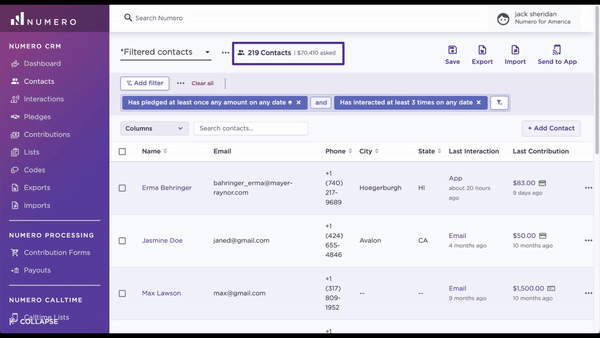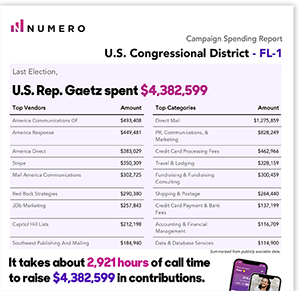Running for a state office is a great way to make a difference in your state and impact your local communities. As a state elected official, you can influence policies, programs, and laws in numerous areas of life:
- Education
- Healthcare
- Economic development
- Conservation
- Infrastructure
- Law enforcement
- Human rights
- And more!
But running a political campaign for the first time can feel like a lot to take on. You might be wondering where to start, how to raise money, or how to encourage people to vote for you.
Well, worry no more! This handy guide will teach you specifically how to run for state office. Here, you’ll learn what research to conduct and what strategies to use to build a successful campaign. Ready to begin?
Table of Contents
Start at the Beginning
Before you can start fundraising or building your campaign, you must zero in on and understand the office that you’re running for. This section will help you navigate the research necessary to answer some key questions.
What offices can I run for?
Like the federal government, state governments are divided into three branches: executive, judicial, and legislative. The office you choose to run for will depend upon your professional and lived experience. Not sure how your specific experiences translate into picking a certain office? That’s okay. Examining the types of offices in each branch will help you start to narrow things down.
State Executive Offices
The executive branch of the state government oversees the application and enforcement of new and existing laws. Here’s a list of the commonly elected offices for the state executive branch:
- Governor
- Secretary of State
- Attorney General
- Superintendent of Schools
- Treasurer
- Auditor
- Commissioners (natural resources, insurance, labor, public service, etc.)
Not all executive officials are elected; some are appointed. Whether a position is filled through election or appointment will also vary state to state. Check with your state’s election website to find out more (we’ll discuss this more in a bit).
State Judicial Offices
The judicial branch of the state government comprises judges who, again, are either elected or appointed. The process for judicial elections is determined by the state and will outline the following aspects:
- Whether judges are elected or appointed
- Whether there are judicial terms and retention voting
- Whether the elections are partisan or non-partisan
For example, Indiana has retention elections for several of the courts that take place every 4–10 years, depending on the court. Meanwhile, Vermont holds partisan elections (with no retention elections), but only probate courts are elected.
State Legislative Offices
The legislative branch of state government contains the State Senate and the State House of Representatives, sometimes called the State Assembly. This branch is the lawmaking branch of the state government, which means that you’ll help research, write, and oversee new bills for the state.
State legislative offices are elected positions (unless your state fills vacancies through appointments instead of special elections). State laws and constitutions determine several aspects of the legislature:
- Age and residency requirements to run
- Total number of senators and representatives in the legislature
- What term limits will apply
Terms are usually 2–4 years in length, and some states will have term limits that set the number of terms a person can serve (sometimes consecutively, sometimes collectively).
Visit your state legislature’s website to learn the specific rules for your state. Not sure where to look? Congress.gov has an interactive U.S. map that will let you look up legislative websites by state.
All this being said, knowing the office you want to run for is only part of the early research you should conduct. You’ll also need to know your chances of winning. To figure out if you can win, you need to know who’s already in office, what their campaign budget was like, and what kind of support they have.
Let’s start with the who.
Who are my state elected officials?
Figuring out who is already in office is easy once you’ve found the website for the branch of state government for which you’d like to run. For example, New Hampshire’s legislative branch website has a side menu that helps you easily determine who is in office and find their contact information, as shown below.
As you can see, the website also lets you search bills, laws, and calendars. You can use this information to attend meetings or do research to become more familiar with your competition. Knowing the issues that competitors focus on and what their track record is within their office will help you shape your own political messaging.
Each state sets up its own system for collecting government information for citizens to use. Let’s look at California’s government website, shown below, to illustrate this notion.
The government homepage has links to all the different branches of government at the top, but when you scroll down, you see what’s shown in the image below:
As the screenshot shows, the directory and contact information are displayed on the California Secretary of State website. Meanwhile, looking up a bill will take you to the state legislature site. For any state, be aware that such information has the potential to be spread across multiple websites. That said, the information should be there, but you might have to be a little creative in finding it.
Now that you know who’s in office, it’s time to figure out what kind of support they have. There are two questions to consider: how did people vote, and how much money did the candidate fundraise?
We’ll answer the first question now, and we’ll use the second question to jumpstart the information on fundraising.
First, let’s look at the vote.
What were the election results in the last election?
In this section, we’ll dig into your state’s election website. These sites are home to a lot of election data that will help you understand the present and historical voting trends of your area.
Because each state collects and presents their own information, finding this data can be a little tricky. Some states will have the data on the Secretary of State website. Other states have election boards (sometimes by county) who have their own websites and data.
The FEC has a State Election Offices directory for a shortcut to finding the appropriate site in your state.
To give you an example of how election sites will help you understand what kind of support your campaign would have, let’s look at the New York Board of Elections website, shown in the screenshot below.
Here you see a collection of information covering various election-related topics. You can, for instance, find election results to help you determine the margins the previous candidate won their campaign by. There are also enrollment statistics broken down by county, district, and office. Knowing enrollment data will help you strategize your voter outreach efforts in both the primary and general elections.
As an aside, election websites provide tons of other useful information that will help you along the way. Here’s a short list of some of the additional info you might find:
- Resources for running for office
- Campaign finance information
- Election calendars
- Elected official directories
- Voter registration
How to use this data
Information gleaned from your state government’s election sites will give you a better understanding of what office to run for, who currently holds the office, and the date of the next election. The data will also tell you how many people are registered to vote, how many voted in specific elections, and how those votes were cast. Often, this data goes back for decades.
Getting organized with the above information gives you concrete numbers to use as goals that shape your campaign. You should be able to answer a number of questions, including the following questions:
- How many people are affiliated with a party? How many remain unaffiliated?
- How many people were registered to vote but didn’t?
- How many people voted for the incumbent?
- What kind of resources will you need to reach out to voters within your party who are either undecided or registered, but inactive voters?
Answering the last question will require diving a little deeper into election data to determine how turnout differs based on the election. This distinction leads to the next question you should try to answer.
How likely are voters to participate in state and local elections compared with national elections?
Voter turnout varies depending on the type of election. State and local elections tend to have smaller turnouts than federal elections, and presidential-year elections encourage more voter participation than midterms.
These variations in turnout are why campaigns for state and local offices benefit from canvassing, phonebanking, and GOTV efforts. The public might not even be aware of an upcoming election. Therefore, doing the leg work and informing voters of the upcoming election and your candidacy within that election are crucial steps to putting yourself in a position to win a local election.
Voting data on turnout and election results ultimately give you a feel for how much work you’ll need to do to generate the public support needed to win. But there’s another indicator you can use to measure support for a political campaign: fundraising.
So let’s switch gears and talk about how campaign finance data can help you gauge the strength of your competition. The same data will also let you know what kind of support (or campaign budget) you’ll need to succeed in your bid for state office.
Fundraising
Fundraising is the cornerstone of a political campaign. Without a healthy budget, you won’t be able to pay for a campaign staff, marketing, or canvassing. The amount of money you raise can also lend credibility to your campaign, signaling to contributors outside your network that you’re a viable candidate to invest in.
In fact, reporting a lot of cash on hand in your financial disclosures during the primaries can make the general election go a lot more smoothly. The amount of cash on hand you have will signal to potential donors that you have support and are running a savvy campaign, making them more likely and more willing to donate to your campaign.
Now that we’ve covered the basics, let’s answer some important questions.
How much does it cost to run for a state office?
To answer this question, you need to find campaign finance data specific to the office you’re running for. Sometimes this information can be found on the election website for your state.
Campaign finance data will also be available through state government websites. Let’s walk through an example of how to find finance data for a specific office in a specific state.
Say you want to run for State Senate in Florida, and you want to know how much it would cost to run. The state’s Campaign Finance Database can be found on the Florida Division of Elections website. There, you’ll find the data arranged into four categories. You’ll also find that the data goes back to 2010. You can see how the data is presented in the screenshot below.
Now, using the list of senators found on the Florida Senate website, look up the current senator for your district. Plug this information into the database form (pictured below).
The results of that search will give you a total of the senator’s reported political contributions for the year in question (in this case, 2020). We recommend that you take some time to research a few other senators and see what their contributions looked like as well. Having a wider perspective will give you an idea of what range of funds you’ll need to raise. We’ve provided an example chart with finance data for multiple state senators below.
As the chart shows, to run a competitive race for state senator in Florida, you’ll need to raise hundreds of thousands of dollars.
Another approach to gathering data is to dig through the campaign data of senators in your district throughout the years. Such information will help you gauge how much budgets have increased over time. Information about inflation in political budgets will allow you to calculate your own budget more accurately.
With the data you collect, you’ll be able to map out how much money you need and where that money might come from.
Who do I ask for contributions?
Speaking of where the contributions might come from, these early research stages of running for office should include time for you to compile a list of potential donors. Start with literally everyone you know. Comb through your contacts, catch up with old acquaintances, and ask friends and family if they know anyone who might be interested in contributing.
Asking for money can feel like a daunting, socially awkward task. But realistically, a political campaign is one of the most socially acceptable times to ask someone for money. In fact, the more your campaign raises (especially in the beginning), the better your campaign looks to potential supporters.
Let’s briefly explore how all of that works.
How does fundraising help my campaign seem credible?
Raising a lot of money early in your candidacy will signal to potential contributors that you have a lot of support. The purpose of a political campaign is to win, and often the candidate who raises the most wins. So starting out your campaign with a decent amount of money shows that you’re a serious contender.
That’s why some people take out personal loans and invest in their own campaigns early on.
What methods can I use to fundraise?
Fundraising comes in many forms. Here are a few common methods:
- Call time: Call time is a set amount of time each day that you dedicate to calling potential contributors, discussing your campaign with them, and asking for contributions. You’ll need to do a fair amount of donor research ahead of time to ensure you have relevant information for the calls (who they are, how much they’ve contributed before, what connection you might have with them, etc.)
- In-person events: These events consist of dinners, house parties, cocktail hours, concerts, rallies, and more—during which you or a co-host will greet and entertain potential donors. Use in-person events as an opportunity to present your message to potential contributors. Co-hosts will often be someone who’s already donated to your campaign, and the guests will be people the co-host thinks might want to support you.
- Virtual events: The world is increasingly online. The onset of COVID-19 during the 2020 presidential elections made it more important than ever for campaigns to utilize online spaces for fundraising. Whether it’s live-streaming on social media or hosting a virtual game night, you’ll need to tap into some of the many ways to connect with contributors in a meaningful way online.
Work with your campaign manager, finance director, or fundraising consultant to plan the most impactful events you can.
Before you start fundraising, however, there are a number of things you’ll need to do to prepare.
What do I need to start fundraising?
Campaign finance laws require keeping all personal funds separate from campaign funds. To begin fundraising, you’ll therefore need to set up your political campaign. Here are the steps to do just that:
- Register as a candidate by forming a political committee.
- Get an EIN from the IRS, which will give you credibility with banks.
- Open a bank account with an appropriate bank.
Finance directors or fundraising consultants can help you set up your campaign and accurately report your contributions, keeping you in compliance with campaign finance laws.
How is campaign funding regulated in state elections?
In general, campaign finance laws limit the amount of money you can receive from any one source. While federal elections are subject to contribution limits listed by the FEC, each state is free to set its own limits. You’ll therefore need to research the laws specific to your state.
Some states will have simple laws, while others have more complex laws. Take New York, for example. Its campaign contribution limits are determined by a formula based on registered voters in the relevant area. California, on the other hand, designates its contribution limits by elected office and the types of contributors. Some states have no contribution limits.
Luckily, you can find the information for relevant state campaign finance laws in the same places you found contributions and/or election data. Take the time to familiarize yourself with your state’s campaign finance laws to ensure your campaign stays in compliance.
With the bulk of the research complete and your campaign officially set to accept contributions, you’re ready to set your budget and figure out your staff.
Building the Campaign Budget
If you refer back to the campaign finance chart above, you’ll see that many of the candidates needed nearly every dollar they raised. In other words, campaigns are expensive, and budgets need to be carefully managed.
Part of managing your budget wisely will be to have a realistic idea of your expenses before you even start raising money.
What are my expenses?
You’ll need to consider a range of expenses when you’re building your campaign budget. Here are some of the common expenses you’ll encounter:
- Overhead expenses: You’ll need to pay for things such as a P.O. box, campaign office space, utilities, and traveling expenses.
- Fundraising events: You’ll need to spend some money on venues, entertainment, and food for your fundraising efforts.
- Staffing: You’ll need staff for your campaign. We’ll break down what kind of staff you need for a state-level campaign in the next section, but expect to include staffing costs in your budget.
- Marketing: You’ll need to pay for TV spots, mailers, flyers, yard signs, and social media ads, among other types of advertising. Plus, the advertising costs will increase the closer you get to the general election.
Try to keep your costs as low as possible for as long as possible. Remember, you want your cash on hand to be impressive, especially early in your campaign.
Here are a few tips to manage your costs and maximize how your cash on hand works for you:
- Don’t hire a full staff right away. Keep a bare-bones staff during the primary if possible, and then hire extra help as you get closer to the general election.
- Wait to pay your campaign bills until after you’ve filed your quarterly finance disclosures, which allows you to report more money on hand for potential contributors to see.
- Keep fundraising event costs to a minimum by accepting in-kind donations (e.g., donated venues or food) and by enlisting a co-host who helps offset some of the costs.
Of the above tips, managing your staffing costs will be the trickiest. You want to have enough staff to effectively run your campaign, but you don’t want to hire a full staff too early and drain your resources. We’ll discuss how to balance your staffing needs with your budget needs in the next section.
What kind of staff do I need for a state-level political campaign?
Staffing at the state level can vary quite a bit because of the various offices available to run for, from governor to state assembly. For instance, a gubernatorial campaign could mirror the staffing level you may see on a U.S. Senate campaign, while a state legislative campaign could make do with just a campaign manager.
For more information on staffing and the different types of roles you can hire staff to fill, check out our blog post on political campaign staff.
Ultimately, a good rule of thumb to guide your staffing investment is to keep your spending below 15% of your overall budget, allowing you to reserve the rest for voter contact.
Voter Outreach
State and local elections tend to have a much lower turnout than federal elections. Roughly only 15%–27% of registered voters turn out for these smaller elections, and most of those who do show up at the polls are older and affluent.
With those facts in mind, this section will discuss practical ways to encourage voter turnout for your state campaign. We’ll focus specifically on increasing turnout during elections that don’t have a competitive top of the ticket to drive turnout (i.e., special or off-year elections, midterms, etc.).
How do I increase voter turnout for state and local elections?
The reasons that voters don’t turn out for down-ticket elections can vary. Here are some of the main reasons:
- Not knowing there is an election
- Not knowing what issues or offices are being voted on
- Not being able to take time off to get to the polls
- Not understanding how state or local government functions or affects daily life
- Not completing their ballot after the top of the ticket (president, statewide offices, congress, etc.)
To counter these factors, take steps to raise awareness about state and local issues and about you as a candidate.
Another approach is to minimize barriers local voters will face in reaching the polls. GOTV efforts can start by encouraging people to register for absentee ballots, for example.
What marketing methods should I use?
There are many simple ways to inform voters that an election is about to take place:
- Canvassing, phonebanking, and text banking inform voters of the election, your candidacy, and the issues being voted on.
- Political endorsements from local businesses, organizations, or celebrities bring awareness to your campaign and to the election in general.
- A strong, well-maintained social media presence will help you stay in almost daily contact with voters and supporters. This degree of access to voters gives you time to inform them of your campaign, what issues matter to you, and how/when to vote.
- Targeted voter ads on streaming services or YouTube will help you engage with more voters. Young and low-income voters, for instance, are the ones most disengaged from smaller elections, and traditional TV or radio spots won’t reach these voter groups as well.
- Paid media (e.g., mailers, digital ads, and television ads), if not prohibitively expensive, can help make voters aware of not only the upcoming election but also your campaign positions and you as a candidate.
- Yard signs signal to local communities that you’re a candidate vying for their attention.
Customize your message and methods based on the voters you’re targeting with each marketing medium. GOTV or turnout efforts geared toward older, more affluent groups will be less impactful on the outcome of the election than organizing for transportation to the polls for lower-income voters—for a simple reason: older voters are already voting.
Persuade the older, more reliable voters on why they should support you versus your opponent, and target younger, more sporadic voters with turnout messaging (if you can assume they will vote, they will generally support you).
Persuasion and turnout are both highly crucial factors. Both have been shown to impact election results. Use voter data to target your marketing universes, and establish a marketing/field strategy that reaches each group.
Be the most proactive in Get Out the Vote efforts in the days leading up to the general election. Once votes are cast, all you can do is wait for election results.
Win or lose, you’ll still have a few small details to attend to once the campaign has finished.
After the Election
Ideally, you’ve won the election and are gearing up for your first day as an elected state official. You can also use this time to settle your campaign debt by using the remaining campaign funds to pay any outstanding bills. If you took out a loan to help with early fundraising, you can also use campaign funds to pay off that loan.
Have remaining funds? Save them to use for your next campaign. If you’ve lost and don’t plan to run again, remaining funds can be donated to various organizations.
If you plan on running for another office, it would be wise to retain your campaign website. Campaign funds can be used to maintain the domain so that you can keep your fundraising and branding in place, which can save you money down the line. Updating the site is much easier than starting over from scratch.
Time to Get Started!
Running a campaign isn’t easy, but the hardest part is simply getting started. What you’re building now is your foundation for everything: your branding, your donor lists, and your research into voters and peers.
While we’d love for you to succeed in your first run for office, losing your campaign will still set you up for future success. Win or lose, you can learn important lessons from your campaign and continuously build on and expand the base of support you built in your first run for office.
So keep learning, and good luck!


![The Complete Political Fundraising 2021 Guide [with ideas]](https://numero.ai/wp-content/uploads/2022/01/The-Complete-Political-Fundraising-2021-Guide-with-ideas-1-768x719.png)









